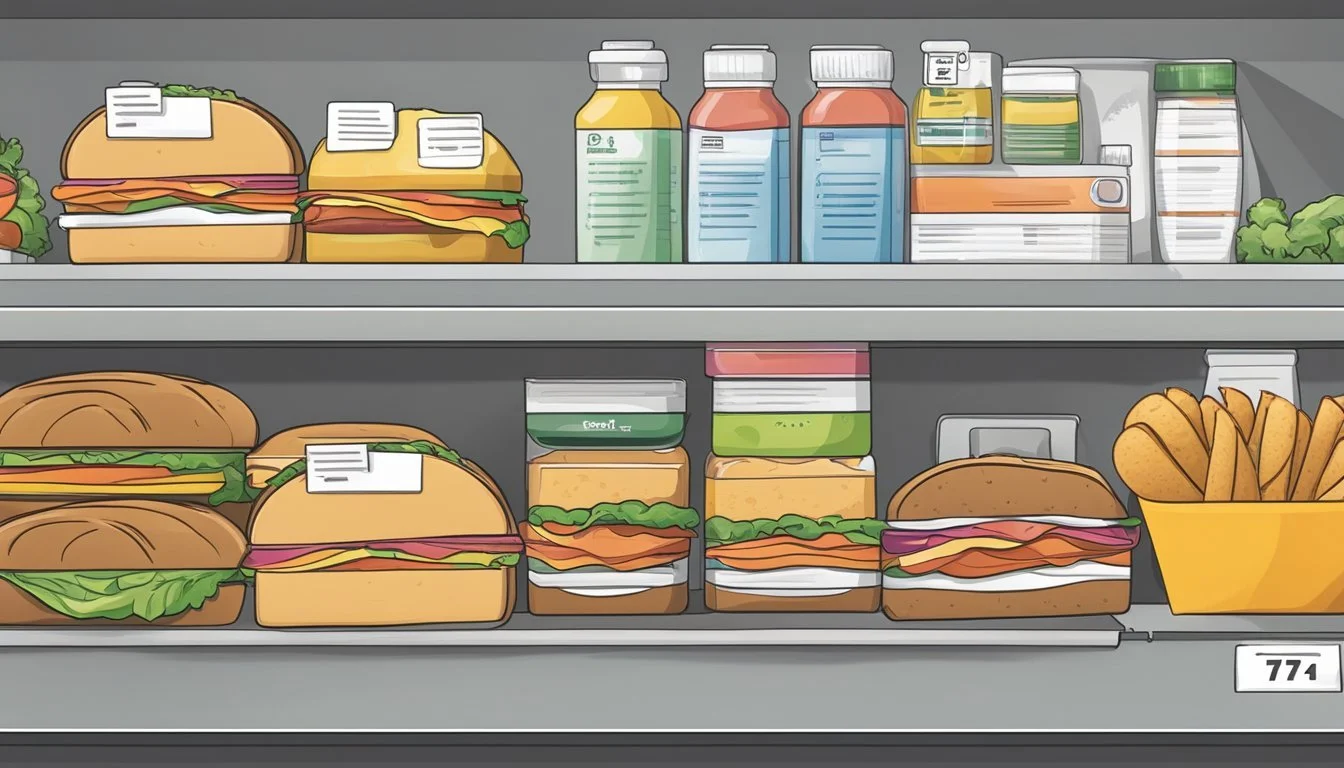How Long Do Sandwiches Last?
Shelf Life and Preservation Tips
When determining how long sandwiches (What wine goes well with sandwiches?) can last, various factors come into play. The shelf life of a sandwich depends primarily on the ingredients used, as each component has its own rate of spoilage once prepared. For instance, sandwiches containing dry and less perishable items such as hard cheeses or vegetables like kale and shredded cabbage tend to last longer, generally sustaining their quality for about three to five days when stored properly in the refrigerator.
The storage method also significantly affects a sandwich's freshness. It's generally recommended that sandwiches be wrapped in parchment paper, which can help maintain their texture by reducing sogginess from condensation, unlike plastic bags which may trap moisture. Proper storage in the fridge can keep a sandwich safe to consume for several days, with an average window ranging from three to four days.
However, sandwiches that include perishable ingredients such as meats, fish, or eggs require careful attention. The shelf life for these sandwiches, even when refrigerated, should be monitored more closely due to their higher risk of contamination and spoilage. Typically, such sandwiches should be consumed within a shorter timeframe to ensure safety and quality. When stored in the fridge, these types of sandwiches might be suitable for consumption for up to four days, but it is always essential to check for any signs of spoilage before eating.
Overview of Sandwich Preservation
The shelf life of a sandwich is influenced by the nature of its ingredients and storage conditions. When stored in the fridge, sandwiches generally maintain quality for 3-5 days. Ingredients such as hard cheeses and tough greens are less perishable, thus sandwiches containing these may last towards the longer end of this range.
It's paramount to store sandwiches at a consistent, cold temperature to inhibit bacterial growth. The fridge should be at 40°F (4°C) or below, which is considered as safe refrigeration. Food safety guidelines recommend consuming sandwiches with perishable fillings like meat, cheese, or mayonnaise within 2 to 3 days to ensure they are safe to eat.
Wrapping sandwiches in parchment paper can prevent sogginess while also minimizing exposure to air, which can degrade quality. For sandwiches not consumed after several days, freezing is an option, albeit it may affect texture and taste.
Factor Recommendation Ingredients Less perishable for longer shelf life Storage Temperature 40°F (4°C) or below for safety Wrapping Parchment paper to reduce sogginess Shelf Life 2 to 3 days for perishable fillings; 3-5 days total
Quality after refrigeration can also depend on the bread's (What wine goes well with bread?) freshness and type, with whole grain breads tending to have a shorter shelf life than white breads. Properly stored, sandwiches offer convenience and retained taste for a limited time, aligning with culinary enjoyment and food safety standards.
Factors Affecting Shelf Life
The preservation of sandwich quality involves various factors such as ingredient selection, storage condition, and choice of bread, each playing a significant role in determining shelf life.
Role of Ingredients
Ingredients are crucial in determining a sandwich's longevity. Deli meats like turkey and ham, and moist or wet ingredients such as tomatoes and lettuce introduce moisture, which can lead to sogginess and potential spoilage. Conversely, dry ingredients like peanut butter maintain their texture longer and discourage bacterial growth.
Temperature and Storage Conditions
Sandwiches should be stored in a refrigerator at a temperature below 40°F to slow bacterial growth. Keeping a sandwich in an airtight container helps maintain its freshness and prevents it from absorbing other flavors or odors. Room temperature storage should be limited to a maximum of two hours, especially for perishable items.
Sandwich Types and Shelf Life Variability
The shelf life of a sandwich varies based on its type. Mayonnaise-based sandwiches and those with perishable ingredients such as egg salad or tuna (What wine goes well with tuna?) have shorter lifespans. In contrast, chicken sandwiches or those with preservatives might last a bit longer when properly refrigerated.
Impact of Bread Selection
Bread acts as the foundation of a sandwich, influencing its shelf life. Sliced white bread generally keeps better than whole grain varieties, which tend to become dry or stale quicker. Crusty bread can withstand moisture longer than softer sandwich bread, reducing the risk of sogginess.
Prevention of Spoilage and Contamination
Sandwiches should be prepared with clean hands and utensils to minimize contamination. Using fresh ingredients and ensuring condiments like mayonnaise are not left out at room temperature for extended periods can prevent bacterial growth and spoilage.
Visual and Olfactory Indicators of Freshness
Change in color, odor, or texture are telltale signs that a sandwich is no longer fresh. Visible mold or an off-smell indicates that bacteria have compromised the safety and quality, and the sandwich should not be consumed.
Safety Considerations for Consuming Older Sandwiches
Consuming leftover sandwiches beyond 3-5 days is risky, with an increased chance of food safety issues. Perishable ingredients like dairy, meat, and fish are particularly vulnerable to harmful bacteria, which can lead to foodborne illnesses if ingested.
Proper Storage Techniques
The longevity and freshness of a sandwich hinge on the efficacy of storage methods. Ensuring that a sandwich is stored properly can maintain its taste and quality from preparation to consumption.
Short-Term Storage Tips
When storing sandwiches for short-term use, typically within a day, it's crucial to protect them from excess air and moisture. Sandwiches should be wrapped tightly in parchment paper, which allows the food to breathe and reduces condensation that could make the bread soggy. For added protection, sandwiches can then be placed in a zip-lock bag or Tupperware. When packed for a lunch bag, including a frozen gel pack can help keep the sandwich fresh.
Long-Term Storage Solutions
If sandwiches need to be kept for more than a day, refrigeration is important. They can last in the fridge for 3-5 days depending on the ingredients. To freeze sandwiches, wrap them in aluminum foil or plastic wrap, then place in a zip-lock bag. Sandwiches with drier fillings can maintain their quality better when frozen. Defrosting should be done in the refrigerator to ensure a safe temperature transition.
Best Practices for Airtight Packaging
Utilizing airtight containers is the best way to preserve a sandwich's quality. This method prevents the transfer of odors and keeps the food fresh. For refrigerated sandwiches, removing any excess air before sealing in an airtight container or zip-lock bag extends their freshness.
Maintenance of Optimal Refrigeration
Refrigeration is pivotal for preserving sandwiches in both short-term and long-term scenarios. The fridge's temperature should be set to below 40°F (4°C) to inhibit bacterial growth. Regular cleaning of the fridge is also important to maintain an environment conducive to food preservation.
Maximizing Sandwich Longevity
Ensuring sandwiches maintain their texture and quality over time requires careful selection of ingredients and storage techniques. The following subsections provide specific methods to prolong the freshness and edibility of sandwiches when refrigerated.
Selection and Use of Fresh Ingredients
One must prioritize freshness when selecting ingredients for a sandwich. Fresh ingredients not only impart superior flavor but also tend to last longer in refrigeration. For instance, freshly baked bread, crisp lettuce, and ripe tomatoes are fundamental to both the immediate quality and the extended longevity of a sandwich. A sandwich assembler should always check the ingredients' expiration dates to ensure peak freshness.
Optimizing Ingredient Layering to Reduce Sogginess
The arrangement of ingredients plays a crucial role in preserving a sandwich’s texture. To prevent sogginess:
Place dry ingredients like lettuce or cheese close to the bread.
Add a barrier layer of cheese or a spread to create a moisture shield.
Put wet ingredients like tomatoes, pickles, or sauces in the center. By doing so, the integrity of the bread is protected, reducing the chances of your sandwich becoming soggy.
Utilization of Dry Ingredients as Barriers
Dry ingredients can act as effective barriers against moisture. When constructing a sandwich:
Layer dry, robust vegetables such as shredded cabbage or slices of bell peppers near moisture-sensitive elements like bread.
Use hard cheeses to shield the bread from wetter components like tomatoes or cucumbers. This method ensures that the bread maintains its texture while keeping the sandwich components fresh.
Refrigerating Sandwiches Correctly
The manner in which sandwiches are refrigerated can greatly influence how long they last in the fridge. To optimize the preservation of sandwiches:
Wrap sandwiches tightly in cling film or aluminum foil, or store in an airtight container.
Keep them in the coldest part of the fridge, typically at the back, away from the door to maintain a consistent temperature. A properly refrigerated sandwich can retain its quality for approximately 3 to 4 days.
Consumption and Safety Guidelines
When storing and consuming sandwiches, there are specific safety guidelines one should follow to ensure the sandwich remains safe to eat. These guidelines revolve around proper storage, timely consumption, and recognition of spoilage signs.
Determining the Ideal Consumption Window
The freshness and safety of a sandwich depend largely on its ingredients. Sandwiches with perishable ingredients like meat, cheese, and mayonnaise should generally be consumed within 2 to 3 days of refrigeration. However, those with drier and less perishable items like hard cheeses and tough greens can last up to 3-5 days in the fridge. Beyond this window, the risk of bacterial growth increases, potentially leading to foodborne illnesses.
Meat and Cheese Sandwiches: Consume within 2-3 days
Veggie Sandwiches with Drier Components: Up to 3-5 days
It's essential to keep sandwiches refrigerated below 40°F (4°C) to inhibit bacterial growth. If a sandwich has been left out at room temperature for more than two hours, or one hour if the temperature is above 90°F (32°C), one should discard it to maintain food safety.
Recognizing Signs of Spoilage
One should always inspect a sandwich for any indicators of spoilage before consumption. Visible mold, off odors, unexpected color changes, and altered texture are clear signs that a sandwich should not be eaten. Bacteria like Listeria, Salmonella, and E. coli are concerning when perishable foods are stored improperly or kept for too long, and these bacteria can cause foodborne illnesses without altering the sandwich's appearance or smell. Therefore, adhering to the recommended consumption window plays a crucial role in ensuring safety.
Mold: Visible fuzzy or slimy growths
Odor: Sour or unpleasant smells
Color: Discoloration or spots that are not part of the original ingredients
Texture: Sogginess or sliminess not attributable to the sandwich's contents
Safety and quality go hand-in-hand; thus, to avoid potential health risks, it's imperative that one not only trusts their senses but also remains vigilant about the time-sensitive nature of sandwich freshness.
Special Cases and Considerations
When evaluating how long sandwiches last, one must take into account specific circumstances such as the type of event they are being served at, the variety of ingredients used, and the best practices for storing leftovers to maintain freshness and ensure food safety.
Handling Sandwiches for Events
For occasions like picnics or large gatherings, it is essential to maintain the quality and safety of sandwiches. Refrigeration becomes a critical concern, especially during transport. Sandwiches intended for events should be kept cool during transport using ice packs or coolers. One must remember that sandwiches with perishable ingredients like mayonnaise-based fillings should not be left out for more than two hours (one hour if the temperature is above 90°F), to prevent bacterial growth.
Guidance for Sandwiches with Specific Ingredients
Different ingredients affect a sandwich's longevity in the fridge. Peanut butter and jelly sandwiches, for example, tend to last longer—up to one week—due to the low moisture content. Conversely, tuna sandwiches or those with mayonnaise-based salads are best eaten within 3 days. Sandwiches with hard cheeses and fruit need careful attention, as these ingredients can affect both the texture and safety if stored too long. Regardless of ingredients, however, all sandwiches should be stored in tight, airtight containers to preserve their freshness.
Advice for Leftover Sandwiches
Leftover sandwiches from lunch or dinner should be promptly refrigerated to extend their shelf life. A sandwich's freshness in the fridge is generally maximized when consuming within 3–5 days. It is important to assess each sandwich for signs of spoilage, such as odor and texture changes, before consumption. Leftovers should also be wrapped in aluminum foil, plastic wrap, or placed in airtight containers to prevent cross-contamination and the intrusion of odors from other foods in the fridge.
Conclusion
The shelf life of sandwiches depends significantly on their storage conditions. At room temperature, a sandwich should ideally be consumed within 2-4 hours, as beyond this duration, the risk of bacterial growth increases, especially in temperatures above 90°F. Refrigeration extends a sandwich’s edibility, keeping it safe to consume for 3-5 days, although the optimal taste and texture are usually best enjoyed within the first 48 hours.
Storage Tips:
Room Temperature: 2-4 hours
Refrigerated: 3-5 days
Frozen (up to): 1 month (note that freezing may affect taste and texture)
It is crucial to consider the sandwich's ingredients, as some may spoil faster than others. Meats, cheeses, and egg-based fillings are more perishable and should be kept cold. Bread type also influences lifespan; for instance, sandwiches made with whole grain bread may spoil quicker than those made with white bread due to higher moisture content in whole grains.
To conclude, observance of proper storage methods—keeping sandwiches refrigerated and consuming them in a timely manner—is key to maintaining their freshness and safety. One should always inspect their sandwich for any odd smells or discoloration, and when in doubt, discard it to avoid the risk of foodborne illness.








